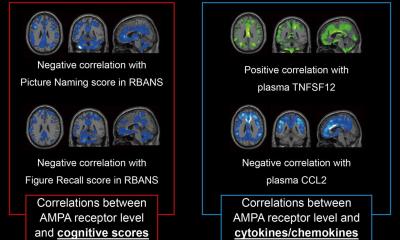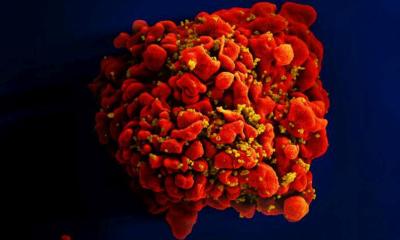New biomarkers allow for better diagnosis in multiple sclerosis
Biomarkers – mainly defined as surrogates serving as indicators for specific biological states – play an ever-increasing role in neuroscience and especially in the management of multiple sclerosis, scientists reported today at the 21st Meeting of the European Neurological Society (ENS) in Lisbon. In analyzing gene expression patterns, immunological changes and imaging abnormalities, physicians are now able to detect complex nervous diseases at an early stage, to better discern them from other types with similar clinical manifestations, to better foresee the outcome and to evaluate whether or not a patient responds adequately to a specific therapy.
Biomarkers – surrogates which can be objectively measured and used as indicators for certain biological states, salutogenetic or pathogenetic processes or responses to pharmacological treatments – are of increasing importance in many areas of modern medicine, but especially so in neuroscience. Neurological diseases are most complex in nature, sometimes difficult to detect, and when relying only on clinical examinations, the effect or ineffectiveness of a therapy might become evident at a late stage.
“Especially in multiple sclerosis (MS) and some related disorders such as optic neuritis and neuromyelitis optica, a number of new biomarkers now greatly help us to quickly and non-invasively confirm or reject a diagnosis, to anticipate the outcome and to check whether or not the chosen therapy is effective in this particular patient,” Prof. Massimo Filippi said today at the 21st Meeting of the European Neurological Society (ENS) in Lisbon. More than 3,200 neurological experts from around the world are currently discussing the latest developments in all areas of their specialty in the Portuguese capital.
Massimo Filippi, Professor of Neurology, heads the Interdepartmental Research Programme “BrainMap” and the Neuroimaging Research Unit at the Scientific Institute and University “Vita-Salute”, Ospedale San Raffaele in Milan, Italy. “These are big steps towards therapies that can be speedily customised to a specific patient’s situation in these most burdensome types of diseases.”
600.000 Europeans suffer from multiple sclerosis
According to epidemiological studies, about 600.000 Europeans and 2.8 million persons worldwide suffer from MS, an inflammatory disease in which the myelin sheaths insulating the axons in the brain and the spinal cord are disintegrated, causing a wide array of clinical manifestations and leading to progressive physical and often cognitive disability. “The huge variability of symptoms, caused by the fact that MS can affect any part of the CNS, along with a lack of meaningful laboratory and paraclinical tests, led in the past to delayed or uncertain diagnoses,” Prof. Filippi added. “We are that much happier, therefore, that in recent years we could trace a remarkable number of biomarkers, allowing for an improved and quickened assessment of the disease and its progression.”
Improved MS diagnosis and differential diagnosis
Optic neuritis, an inflammation of the optic nerve potentially leading to a total loss of vision, can be an early sign for MS. “We now found out that the gene expression patterns in a whole blood analysis show significant differences in patients with optic neuritis compared to healthy controls, which can make an early detection of MS easier in the future,” Prof. Filippi said. Neuromyelitis optica (Devic’s disease) is characterised by inflammatory-demyelination and irreversible tissue loss concentrated in the spinal cord and the optic nerve. Seen by some as a subtype of “ordinary” MS and by others as a different, independent disease, it needs a different course of treatment than MS to achieve optimal results. “Neuromyelitis optica is characterised by an autoantibody profile distinct from that of MS, allowing for an improved differential diagnosis and an early start of the appropriate therapy,” Prof. Filippi added.
Anticipating disease progression
In MS, neurologists discern different phenotypes – including the relapsing-remitting, the primary progressive and the secondary progressive. Each of these has a different prognosis and may require different therapeutic approaches. As a consequence, there is an urgent need to define their pathophysiology. “Some of our new biomarkers make this job much easier,” Prof. Filippi explains. “For example, in so-called black holes, lesions with irreversible tissue damage, the patterns of the microglia activation are different in progressive MS as compared to the relapsing subtype. MR measures could also help characterizing the heterogeneous clinical phenotypes of the disease. In particular, patients with progressive MS have an over-recruitment of the cervical cord on functional MRI scans, which is more pronounced in secondary progressive than in primary progressive MS. In relapsing-remitting MS patients, diffusion tensor magnetic resonance imaging (DT-MRI) allows distinguishing the effects of specific tract damage on disability and cognitive impairment. Finally, in neuromyelitis optica, the presence of NMO-IgG (antibodies which destroy aquaporin-4, a protein serving as a water channel through the cell membrane) already in an early stage identifies patients with a worse prognosis.”
Evaluating the response to treatment for MS
Does an individual patient respond to treatment? This crucial question, too, can in many cases be answered with hitherto unknown efficacy due to new biomarkers and technology to measure them. “The longitudinal atrophy of the spinal cord, a potentially important indicator for disease evolution and treatment response, can now be evaluated more effortlessly by a new segmentation method,” Prof. Filippi continues. “Whether or not a patient responds to natalizumab, a synthetically created monoclonal antibody designed to block the destructive activity of white blood cells in MS, can be assessed by the amount of natalizumab binding to mononuclear cells found in peripheral blood. A marker for the chances that cladribine -- a drug targeted to inhibit the immune system overactive in MS patients --will actually reduce disease activity is the amount of activity measured before treatment: the more relapses, the more active brain lesions and the more progression in disability, the more effective the drug will probably be. The effectiveness of an immunosuppressive treatment in neuromyelitis optica can in turn be measured by the NMO-IgG (aquaporin-4-antibody) level: the lower it is, the better the response to therapy; the higher it is, the more probable are relapses.”
A new area in MS assessment
“With these discoveries, and many more possible biomarkers still under investigation, we are embarking on nothing less than a new area of CNS disease assessment,” Prof Filippi concludes. “Instead of being in the dark for months and years, or dependent on very expensive and burdening diagnostic tools, we increasingly understand an easier-to-read bio-language of the body. It is leading us on relatively simple paths to the right diagnosis and letting us watch the development of disease and/or treatment. We expect this shift in diagnostic paradigms to continue and to yield even more exciting possibilities within the next few years.”
30.05.2011







